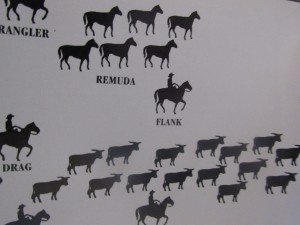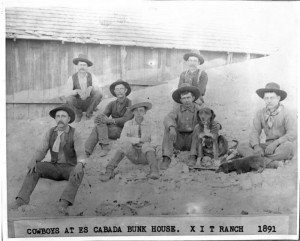
There may not have been any more challenging task for the old west rancher than the cattle drive. The cattle drive after all was how the rancher transported his herd to the rail heads for shipment east. The successful cattle drive ended with a substantial payday. Cowboys were paid and the rancher hopefully made a good profit.
Work on the cattle drive by the cowboy was not easy. Having to sleep on the prairie ground in all weather for weeks at a time could be grueling. One improvement for sure was when famed Texas Panhandle rancher Charles Goodnight developed the chuckwagon out of a military surplus Studebaker wagon after the Civil War.
The Structure of the Cattle Drive
A trail boss will be at the front end of the herd. Cowboys will serve a variety of functions mostly to help keep the herd together and heading in the right direction.
Cowboys ride the point position which means they ride near the front of the herd on either side close to the lead steer. Some of the more experienced men were in this position.
The swing riders ride at a distance behind the point riders to turn the herd in the right direction.
Behind them are the flank riders. These cowboys are positioned to keep the herd from spreading out too far.
Behind the flank riders and at the end of the herd are the drag riders. Drag riders work to keep the herd moving along.
In addition to these cowboys is the wrangler. The wrangler tends to the extra horses brought along on the drive. These horse are referred to by the Spanish word ‘remuda“. The wrangler could also be referred to as a “remudero“. A remuda is simply a herd of horses that cowboys choose their mounts from and travel along with the drive.
A typical late 1800’s cattle drive might employ a dozen cowboys in addition to the trail boss. The trail boss might be the ranch owner or might not be. So many of the large western ranches had overseas investors, mostly from England and Scotland, the trail boss was likely to be a top tier employee or ranch manager. The trail boss needed to be experienced and a good guide because he would be in charge of the herd and the cowboys along for the drive. The trail boss would decide when to start and where to stop at days end.
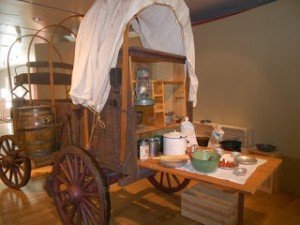
Last but certainly not least was the cook and the chuckwagon. The cook was often given the nickname “cooksie” or “cookie” and might actually take charge of the drive if something were to happen to the trail boss.
Length of Cattle Drive
Cattle drives out of Texas after the Civil War could easily involve thousands of head of cattle. Three thousand head would not be considered overly large.
Cattle drives weren’t fast moving but considering the amount of cattle they would travel ten or more miles per day which wasn’t bad. Depending on the distance to a rail head and considering any unforeseen delays the drive might take a month but typically two months or even more.
Trouble on the Drive
There was a wide variety of difficulties and trouble that could plague a cattle drive. The herd alone could stretch out for perhaps two miles in length. There were plenty of things that can go wrong on a cattle drive.
Just one of these was weather. Who could predict weather with any accuracy in 1885? A thunder clap could cause a herd to stampede, one of the worse things to occur on a drive. A simple sneeze or a sudden horse move could set a herd off in all directions. In addition to the extra time involved in gathering up a herd after a stampede, a cowboy could be injured or killed by falling under a stampede.
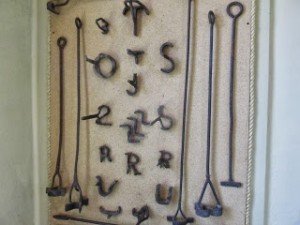
Crossing rivers was mandatory to reach rail heads. A cowboy and/or cattle could be lost to drowning. It was up to the trail boss to locate a suitable place to ford.
One such major river crossing for the Great Western Cattle Trail, sometimes referred to as the Western Cattle Trail or Texas Trail, was located on the Red River between Texas and the then Indian Territory. This was known as Doan’s Crossing and is located about twenty miles north of Vernon Texas. Today this crossing is commemorated with historical markers. See our Doan’s Crossing photo article on our Western Trips site.
Sickness was an ever present menace while on the trail. For the most part the herd was driven away from settlements and medical help could be slim to none. Home remedies were the treatment of necessity.
Indians could also interfere with the cattle drive. If Native Americans were to attack a cattle drive the reason would most likely be to steal beef. Buffalo hunters with their Sharps rifles did permanent damage to the wild bison herds and the need for beef was real. Aside for attacking cowboys on cattle drives to obtain meat, Indians might use the raid to teach their young the art of warfare and to prove bravery.
One of the most publicized Indian attacks on ranchers occurred in eastern New Mexico when Oliver Loving, partner of rancher Charles Goodnight, was severely wounded by Native Americans in September 1867. Loving survived the attack and made it wounded to Fort Sumner New Mexico where he died of gangrene.
Oliver Loving, whose name is part of the historic Goodnight-Loving Trail, was inducted into the National Cowboy & Western Heritage Museum in Oklahoma City.
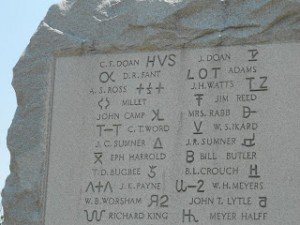
Rustlers could also add to theft on the trail. Rustling was real and was a capital offense. Cowboys would need to be on lookout especially at night to ward off any rustlers.
Large ranchers in many cases employed range detectives.
Rattlesnakes, and there were and are plenty in the west, could cause a herd to stampede. They could either cause the stampede directly with the cattle or cause a cowhand’s horse to react in such a way as to spook the herd. A rattlesnake bite to a cowboy was always a possibility.
Wildfires. Wildfires, range fires or prairie fires could be deadly to both cowboy and animal. The major cause of these fires were lightning and obviously unpredictable.
When the nineteenth century came to a close, railroads had laid track to most of the formerly inaccessible areas of the country and the need for long cattle drives vanished. Today, cattle are transported by truck and railroad and the need for the point, swing, flank and drag cowboy changed with the times.
You may also enjoy the related Trips Into History articles on the links below…
Charles Goodnight and the Chuckwagon
Old Santa Fe Trail Wagon Ruts in New Mexico
We’ve found several good books on the subject of cattle drives, ranchers and ranching. They include…
The Cowboy by author Philip Ashton Rollins
The Cattle Kings by author Lewis Atherton
Charles Goodnight: Father of the Texas Panhandle by author William T. Hagan.
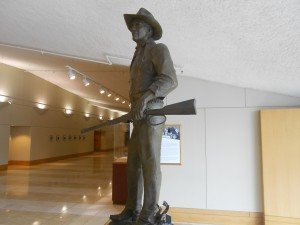
Experience a Cattle Drive Today
While the old west cattle drive is a part of history, there still remains opportunities for the adventurous traveler to experience what life was like on the open range.
For those visiting the Fort Worth Texas area, a small cattle drive is held twice daily at the Fort Worth Stockyards. The stockyards are located off of N. Main Street just a few miles north of the central business district.
Several dude ranches in Wyoming can also give you a good taste of being a cowboy. Check out the Double Rafter Cattle Drives in Ranchester Wyoming and also Two Creeks Ranch located near Douglas Wyoming.
The website www..equitours.com features cattle drive vacations in both the U.S. and abroad. Information on a cattle drive that takes place in Australia can be found at website www.australia.com/explore/events/sa-outback-cattle-drive.aspx
Also, check out the summer cattle drives held every June, July and August in Alberta Canada. More information is found on website www..southernalberta.worldweb.com/MountainView/ToursActivities/CattleDrives/
(Article copyright 2013 Trips Into History. Cattle drive diagrams courtesy TX DOT. XIT cowboys photo from the public domain. Remaining photos from Trips Into History Collection)


